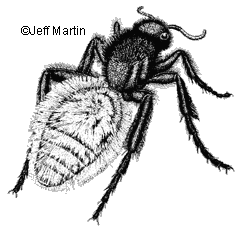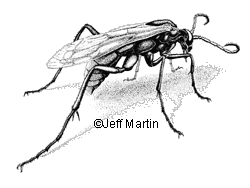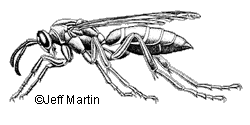Wasps
Wasps comprise an enormous and diverse assemblage of insects ranging from the smallest known insects—tiny parasites of insect eggs—to immense cicada killers and tarantula hawks. Most wasps are predators whose young feed on other insects or arthropods, but a few groups have become vegetarians, similar to bees, and collect pollen to be fed to their larvae. Both sexes of wasps are typically strong fliers, but some species are flightless, and in others, one sex, usually the male, is an excellent flier while the other sex is flightless. Velvet “ants”—actually female wasps that superficially resemble ants—are an example of this.
Perhaps the most conspicuous and commonly seen wasps in the Sonoran Desert are the paper wasps (Polistes). Paper wasps are large, (about 1 inch, or 20 to 25 mm) social wasps that build paper honeycomb nests. Paper wasps are longer, thinner, and more smooth and shiny than honey bees and have longer, narrower waists (called petioles) than do bees. Common paper wasps include the yellow paper wasp, whose color is true to the name; the Navajo paper wasp, which is deep chocolate brown with the end of the abdomen yellowish; and the Arizona paper wasp, which is slightly smaller and more spindle-shaped than the other 2 and is brownish-red with thin yellow cross bands on the abdomen.
| Order: Hymenoptera |
| Suborder: Apocrita |
| Division: Aculeata | Families: Pompilidae, Mutillidae, Sphecidae, Vespidae |
| Sonoran Desert genera: |
Pepsis, Dasymutilla, Sphecius, Sceliphron, Polistes, Vespula |
| Spanish name: avispa |
Some of the most impressive insects in the Sonoran Desert are the enormous tarantula hawks (Pepsis). These 1 to 1¾ inch (25 to 45 mm) wasps sport brilliant gun metal, blue-black bodies carried on fiery orange wings. The desert contains more than a dozen species, some of which have jet-black wings instead of orange wings.
 |
Velvet ants (Dasymutilla) are among the more colorful of all organisms in the desert. Females of these large ant-like wasps can be seen scurrying over sandy or bare soil surfaces during warmer seasons of the year. More than 3 dozen species live in the Sonoran Desert of Arizona. They range in size from tiny J inch (4 mm) species to huge 1 inch (25 mm) giants. Most are clothed in red, orange, yellow, or silver coats of hair-like setae (bristles) and look like moving fuzzy cotton balls. Particularly large velvet ants include the black and red D. klugii and Satan’s velvet ant, which is black with a yellowish-white furry abdomen. The glorious velvet ant (D. gloriosa) is a long-haired, totally white velvet ant that looks like a creosote bush seed on legs.
Cicada killers (Sphecius grandis) superficially resemble huge yellowjackets or hornets. Yellow with tan patches, they are 1 to 1½ inches (25 to 40 mm) long. These powerful fliers have large compound eyes.
Mud daubers (Sceliphron caementarium), sometimes called dirt daubers or mud wasps, are thin, 1-inch (25 mm) long black wasps with yellow legs, and long, yellow-thread waists. They are named for their habit of building mud nests under bridges or eves of houses, or in other protected areas.
Life History
 |
The paper wasp is social insect whose life cycle begins as a solitary mated queen. The queen overwinters deep in rock cracks, behind peeling tar paper, or inside enclosures. In spring the queen builds a paper nest suspended from a thin stalk in a protected rock crevice, among thick vegetation such as dead fan palm leaves, or under the overhang of a man-made structure. She constructs a small cluster of paper hexagonal cells and lays an egg in each. The queen then feeds the larvae that hatch from these eggs a diet of caterpillar “meat balls.” When the first young worker wasps emerge from their pupal cells, they assume the tasks of hunting caterpillars, collecting material for making papier mâché for nest expansion, and collecting water for cooling. The queen then ceases all work except egg laying. By late spring, the colonies have grown to contain 20 to 50 wasps; by late summer as many as 200 wasps may be present. At this time new queens and males are reared. After mating, the new queens imbibe nectar to fatten for the winter. By late fall, the queen mother and workers die, the nest is abandoned, and the next generation of queens goes into hibernation.
Tarantula hawks, so named for their huge size and hawk-like hunting strength, hunt tarantula spiders. During the warm months female wasps search the ground for tarantulas. Once prey is located, the tarantula hawk bites onto a leg of the tarantula and with its long, strong, sharp stinger, pierces the spider near a leg base, and injects paralyzing venom. The limp, but living, spider is dragged into an appropriate hole, sometimes the spider’s own burrow, where a single egg is laid on the spider. The wasp then seals the burrow to complete her work. When the egg hatches, the larva consumes the spider and then pupates; the next spring the adult emerges to complete the life cycle. Males do not hunt, but are frequently seen visiting flowers of milkweeds, western soapberry trees, or mesquites.
Velvet ants, cicada killers, and mud daubers have life cycles similar to tarantula hawks. Wingless female velvet ants search the soil surface for burrows of wasps or bees that can serve as hosts. Male velvet ants fly above the surface looking for females. Once a female velvet ant locates a nest of a suitable host, she enters, opens a cell of a host larva that has completed feeding or has already pupated, lays an egg on or near the host, and closes the cell. She does not sting or paralyze the host. Cicada killers search for cicadas, which they sting to paralyze, and then transport back to their nests dug in sand or soft soil. One to 3 cicadas are provisioned per cell for each young. Mud daubers provision their mud cells with spiders they have captured and paralyzed by stinging. The larvae of all of these wasps feed on the provisioned prey, consuming it entirely, and pupate to emerge the next year as adults.
Ecology and Biology
 |
Most wasps are specialized hunters that track down their prey using smell and sight combined with knowledge of the habitat, activity periods, and behavior of the prey. A solitary wasp usually subdues its prey with a sting that either kills the prey or paralyzes it briefly or permanently. (Tarantulas stung by tarantula hawks can live completely paralyzed for months.) Social wasps, including paper wasps, never sting their prey. Instead, they use their powerful cutting mandibles to chew the prey into pieces to feed directly to their larvae. The venom of social wasps is used only for defense. The most serious predators of social wasps are birds, mammals, and reptiles. The sting and venom have evolved to be effective weapons against these large animals. Venoms are ideal defenses because they can be injected via the stinger directly into the assailant’s body where they cause pain, toxicity, or both. The stingers of wasps, and their relatives the ants and bees, are modified ovipositors used to deliver venom rather than to lay eggs. Thus, only females can sting; males are completely harmless. Unlike honey bees, which can only sting once because the barbed sting remains in the victim’s skin after stinging, thus evisceratating the bee, wasps have smaller barbs on their stings and can withdraw the stinger to sting several times. The effectiveness of wasp stings and venoms as defenses has allowed wasps to evolve bright warning colors of red, yellow, orange, or white on a black or dark background. These conspicuous warning color patterns are called aposematic, and their brightness usually correlates with the degree of painfulness of the sting. Potential predators and humans alike learn to avoid beautiful aposematic wasps. Failure to heed the warning often results in an excruciatingly painful, and possibly toxic, sting. Indeed, tarantula hawks deliver the most painful sting of any United States or Mexican insect, a sting that is many times more painful than that of a honey bee. Velvet ants are also true to their bright colors. They not only possess the longest stingers of stinging wasps, but deliver a powerful sting that is not soon forgotten. Although wasps can sting people, they rarely do so, and then only when they are captured, or in the case of paper wasps, when their nests are threatened or disturbed.










